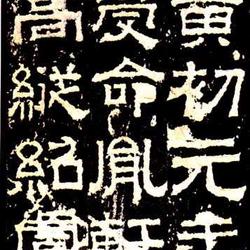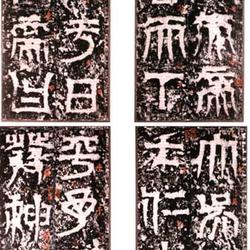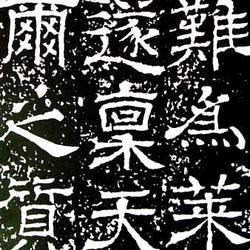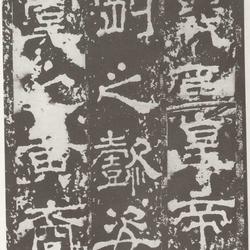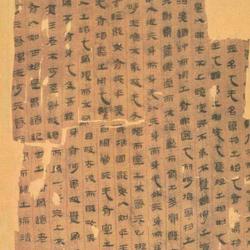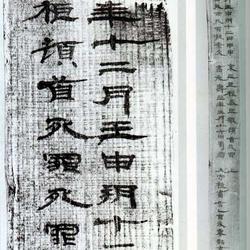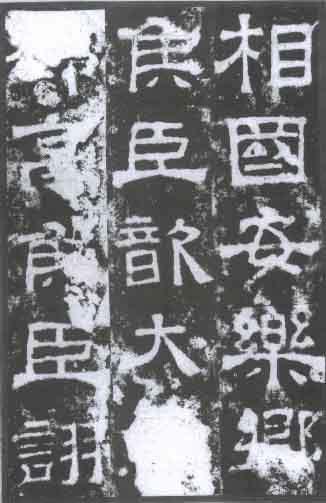
The full name is "General Wei Gongqing's Honorary Commemoration", also known as "Hundred Officials Encouraging Entrance Table", "Encouragement Monument", and "Shangzun's Honoring Announcement". It is recorded that in the last years of Emperor Xian of the Eastern Han Dynasty, Hua Xin, Jia Xu, Wang Lang and others persuaded Cao Pi to advance. This was actually a political maneuver played by Cao Pi. He then formally abdicated and proclaimed himself emperor, and was known as Cao Wei in history. The monument does not contain the year and month when the stone was established, with 32 lines and 49 characters in each line. His text is recorded in Pei Songzhi's annotation in "Three Kingdoms·Wei Zhi·Ji Wendi", which is slightly different from this stele. Gu Nanyuan's "Li Bian" dated the first year of Yankang, Emperor Xian of the Eastern Han Dynasty (220). Gu Yanwu's "Inscriptions on Epigraphy and Stone" believes that this inscription should be in the first year of Yankang, but was engraved after Wei Huangchu. This monument has always been named together with another monument of the early Wei Dynasty, "Shou Chan Biao". The two monuments are both located in the Han Xian Emperor Temple in the ancient city of Cao Wei, thirty miles south of Xuchang, Henan. They both face south, one to the east and one to the west, standing majestically against each other. According to logic, we should first encourage people to advance, and then accept Zen, or both at the same time. Since "Shou Chan" was erected in the first year of Huangchu, this monument should not have been erected too late or at the same time as "Shou Chan".
The calligraphy of "The Monument of Shangzun's Name" is famous for its "square, straight and majestic style". It is said that it is written by Liang Hu or Zhong Yao, but neither of them is reliable. Zhao Kuang of the Ming Dynasty said: "This stele may be called Liang Hu's book, or Zhong Yao's book, but there is no evidence. However, the official method is ancient, and it cannot be done by two men. It is naturally a thing between bells and tripods." ("Graphite Engraved Hua") Feng Yunpeng of the Qing Dynasty said: "The narrative carvings are neat and the calligraphy is exquisite. It is naturally a giant stele made in the Wei Dynasty." ("Jin Shi Suo") The calligraphy style of this stele is very similar to that of "Shou Chan Biao", but the font shape is slightly square, just like "Shou Chan Biao" "" mentioned in the article, they are both the forerunners of the calligraphy style of Wei and Jin Dynasties, and their influence is profound and far-reaching for later generations. In the fifteenth year of Emperor Xian's reign (210) of the Eastern Han Dynasty, Cao Cao ordered the monument to be banned. Therefore, during the Cao and Wei Dynasties, apart from a few imperial giants, very few survived. During the Cao and Wei Dynasties, the Three Kingdoms were established, Confucianism, Taoism, and Buddhism were coexisting, and social thinking was relatively open. The writing style is also clear and simple. Therefore, the carvings in the early Wei Dynasty are ethereal and majestic, contrary to the ancient and elegant style of the late Han Dynasty. As far as the evolution of Chinese character fonts is concerned, the inscriptions in the early Wei Dynasty were the bridge from official to regular script; as far as calligraphy style is concerned, they infiltrated and irrigated the calligraphy of the Jin and Southern and Northern Dynasties and even the Sui and early Tang Dynasties; therefore, both in the history of changes in Chinese character fonts and In the history of calligraphy art, they all occupy an important position.

